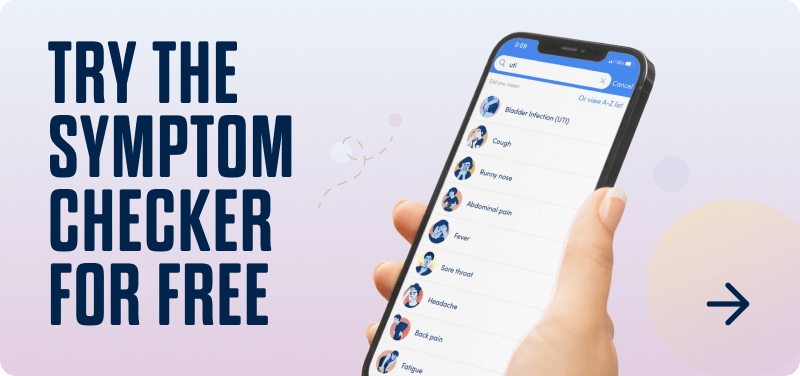Although chlamydia is one of the most common sexually transmitted diseases (STDs), many people have no idea that they’re infected.
Like gonorrhea and HPV, chlamydia can occur without any symptoms, and even if you have symptoms, they may not happen for some time.
This makes it hard to figure out what’s going on and when to see a doctor.
To help you stay healthy, in this article, I’ll explain how long chlamydia can take to show up, the symptoms to look for, how to get tested, common treatments, and when to see a healthcare provider.
How Long for Chlamydia to Show Up?
Most people who have chlamydia have no symptoms—at least not at first.
Some never develop symptoms, while others only develop them 1-3 weeks after having unprotected sex with an infected partner.
Below is a breakdown of how long it takes for chlamydia to show up in different sexes and parts of the body.
People with penises
Although the symptoms of genital chlamydia differ slightly between people who have penises and those who have vulvas, the time it takes for the infection to show up is the same: Symptoms typically develop 7-21 days after contact with an infected partner.
People with vulvas
The time it takes for people with vulvas and people with penises to experience chlamydia symptoms does not differ: Both usually notice symptoms about 1-3 weeks after exposure.
However, people with vulvas are more likely than those with penises to be asymptomatic: About 90% of women have no symptoms compared with 70% of men.
Throat
Similar to other areas of the body, chlamydia symptoms may take about 7-21 days to show up in the throat.
Chlamydia in the throat is typically caused by having oral sex with someone who has contracted the infection.
Although throat chlamydia is less common, it’s important to ask your doctor for a throat swab if you may have been exposed to chlamydia through oral sex, as this screening is not always part of routine STI testing.
Eyes
Although rare, you can develop chlamydia in your eyes if they come in contact with infected semen or vaginal fluid.
However, you may not realize what’s causing those red, itchy eyes because symptoms can take weeks to develop.
Anus
Receiving anal sex from an infected partner can lead to chlamydia of the anus in men and women.
It’s also believed that if a person with a vulva has chlamydia, during sex, the infection may spread from their cervix to their anus and infect their rectum.
Either way, these infections are often asymptomatic, but symptoms could show up within a few weeks.
Symptoms of Chlamydia
Due to its often asymptomatic nature, chlamydia is known as a “silent” infection.
If symptoms do occur, it can often be weeks after the initial exposure.
Symptoms vary based on where the infection is located:
Cervix (chlamydial cervicitis)
- Vaginal discharge
- Burning sensation when urinating
- Pain during sex
- Abdominal pain
Penis (male chlamydial urethritis)
- Watery discharge from the penis
- Burning sensation when urinating
- Testicular pain, tenderness, and swelling
Throat (pharyngeal chlamydia)
- Sore throat
- Pain the mouth
- Redness in the mouth or throat
- Mouth sores
- Sores around the lips
- Fever
Eyes (chlamydial conjunctivitis)
- Eye discharge
- Red, itchy, or swollen eyes
- Sensitivity to light
Rectum
- Rectal pain
- Rectal discharge
- Rectal bleeding
Testing
Lab tests such as nucleic acid amplification tests (NAATs) and cell cultures can diagnose chlamydia.
Your doctor or healthcare provider may perform one of the following tests:
- Swab: Using a cotton round or stick to take a sample of tissue or fluid from the vagina or cervix for women or from the urethra for men
- Urine test: Peeing in a cup to collect a urine sample to be tested
Many different providers—including family planning centers, private doctors’ offices, STI clinics, hospital clinics, and health departments—typically provide testing for chlamydia and other STDs, so explore your options and pick what is most comfortable and convenient for you.
Whether or not you were exposed to chlamydia or think you may have been, the Centers for Disease Control and Prevention (CDC) recommends annual screenings for:
- Sexually active women younger than 25
- Women 25 and older with new or multiple sex partners
- Women 25 and older whose sex partner has a sexually transmitted infection (STI)
- Sexually active men who have sex with men
- People who are HIV-positive
How long does it take to show up on a test?
Test result times vary depending on what type of test you get and where the test is performed.
The average result times for each type of test are:
- Swab test results: 2-3 days to show a positive or negative result
- Urine test results: 2-5 days to show a positive or negative result
Retesting for chlamydia
Chlamydia can resist treatment and it’s also possible to be infected, cure the infection, and then be infected again.
For these reasons, it’s best to retest for chlamydia three months after treatment.
Complications
Chlamydial infections can lead to serious health problems with both short- and long-term consequences when unnoticed and untreated:
- Pelvic inflammatory disease (PID) in women. This can permanently damage the fallopian tubes, ovaries, and uterus.
- Pregnant women can pass chlamydia to their baby, who may develop an eye infection or pneumonia.
- Inflammation near the testicles in men. Called epididymis, this causes pain and swelling that, if left untreated, could affect fertility.
- Sexually acquired reactive arthritis (SARA). This condition causes the joints, eyes, or urethra to become inflamed and is typically more common in men.
Treatment
Chlamydia is a bacterial infection and can be effectively treated with antibiotics.
Your doctor may prescribe one of the following medications:
- Azithromycin (Zithromax)
- Doxycycline (Oracea)
- Erythromycin (Erygel)
- Levofloxacin (Levaquin)
- Ofloxacin (Floxin)
Follow the dosage instructions closely and take the full course of antibiotics, even if your symptoms go away sooner.
If you stop taking antibiotics early, the infection may come back.
To prevent the spread of chlamydia, wait to have any sexual contact until seven days after taking the single dose of antibiotics or after completion of all seven days of the multi-dose medication.
Because it is somewhat common to get a repeat infection of chlamydia, it’s a good idea to be tested for it again about three months after treatment.
When to See a Doctor
If you are sexually active and displaying symptoms of chlamydia, or you believe you were exposed to the bacterial infection through a sexual partner, see a doctor for evaluation and treatment as soon as possible.
The CDC advises sexually active women under 25 years old get screened for chlamydia every year. It’s also a good idea to be tested when beginning a sexual relationship with a new partner.
Frequently Asked Questions
K Health has strict sourcing guidelines and relies on peer-reviewed studies, academic research institutions, and medical associations. We avoid using tertiary references.
-
Chlamydia – CDC Fact Sheet (Detailed). (2021).
https://www.cdc.gov/std/chlamydia/stdfact-chlamydia-detailed.htm -
Chlamydia in Teens. (n.d.).
https://childrensnational.org/visit/conditions-and-treatments/infectious-diseases/sexually-transmitted-infections/chlamydia -
Overview: Chlamydia. (2018).
https://www.nhs.uk/conditions/chlamydia/

 Medically reviewed
Medically reviewed
